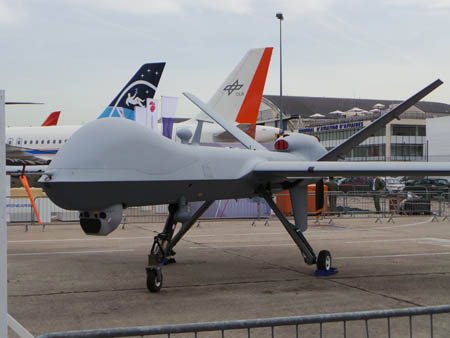 If used in numbers, the Air Force’s MQ-9 Reaper remotely piloted aircraft would still be a valuable asset in contested airspace against a sophisticated enemy, said Frank Pace, who leads General Atomics Aeronautical Systems’ Aircraft Systems Group. “I don’t think people really understand the effect of low-cost quantities and what you could do with an airplane of this type,” he told the Daily Report in an interview last week at the 50th Paris Air Show in Le Bourget, France. Pace didn’t deny that a single Reaper would be “totally useless” if sent in alone against a sophisticated adversary. “It’s going to get shot down. I agree,” he said during the June 18 interview. However, he said, the story would be different if the Air Force employed a large number of Reapers—Pace used 40 in his narrative—as part of a larger strike package. These Reapers, somewhat stripped down compared to today’s configuration and, as a result, more affordable, could serve as jamming assets, for example, to help disrupt the enemy’s air defenses, he said. “There is confusion you want to create in a war” and “I think the ability to make confusion comes with numbers a little bit,” he said. “If you use [Reapers] to create confusion, then the other airplanes are going to be that much more survivable.”
If used in numbers, the Air Force’s MQ-9 Reaper remotely piloted aircraft would still be a valuable asset in contested airspace against a sophisticated enemy, said Frank Pace, who leads General Atomics Aeronautical Systems’ Aircraft Systems Group. “I don’t think people really understand the effect of low-cost quantities and what you could do with an airplane of this type,” he told the Daily Report in an interview last week at the 50th Paris Air Show in Le Bourget, France. Pace didn’t deny that a single Reaper would be “totally useless” if sent in alone against a sophisticated adversary. “It’s going to get shot down. I agree,” he said during the June 18 interview. However, he said, the story would be different if the Air Force employed a large number of Reapers—Pace used 40 in his narrative—as part of a larger strike package. These Reapers, somewhat stripped down compared to today’s configuration and, as a result, more affordable, could serve as jamming assets, for example, to help disrupt the enemy’s air defenses, he said. “There is confusion you want to create in a war” and “I think the ability to make confusion comes with numbers a little bit,” he said. “If you use [Reapers] to create confusion, then the other airplanes are going to be that much more survivable.”
The U.S. military is maintaining a beefed-up presence in the Middle East, including fighters and air defense assets, following the U.S. strikes on Iranian nuclear facilities June 22 and subsequent retaliation by the Iranians against Al Udeid Air Base in Qatar.
